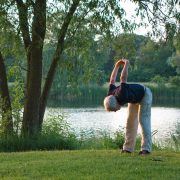Five Common Golf Injuries and How to Avoid Them
Golf is a beloved passion enjoyed by millions around the world, and the season has officially begun here in New England. Let’s talk about golf injuries. Most golfers won’t let anything get in the way of tee time – but when you’re dealing with back, knee, elbow, or shoulder pain – playing 18-holes is just not as fun.
An injury of any kind during golf season not only impacts your performance – but it keeps you from enjoying the game to the fullest.
Your buddies are walking the course while you have to drive the cart… Instead of focusing on your swing, you’re thinking about your pain and whether or not you should push through it…
The good news is that with the right knowledge and preparation, you can avoid some of the most common injuries impacting golfers.
Here are five of the most common golf injuries and what you can do to avoid them:
1. Back Pain
Back pain is the most common injury to plague golfers. Repetitive bending and twisting is a well-known source of back problems – and that’s literally all you’re doing when you play golf. While practicing proper swing mechanics can help, it might not be enough.
If you lack adequate mobility in your spine, for example, the best swing in the world won’t compete. It’s important that you take time to optimize and maintain good spinal mobility during golf season.
Stretching backwards regularly, and avoiding excessive sitting during the day, are two things alone that could make a huge difference in your back mobility – and pain – and help you to get through golf season injury-free.
2. Elbow Tendonitis (Golfer’s Elbow)
Golfer’s elbow occurs when the tendons on the inside of your elbow become inflamed from the repetitive swinging motion of the golf club. Once again, good swing mechanics can go a long way in preventing this from happening. But it’s also important to consider what’s happening above and below your elbow joint.
If you’ve got a weak rotator cuff, or weak and stiff wrists for example, your elbows will experience added and unwanted strain when trying to do something like swing a golf club. It’s important that you perform regular conditioning of these areas (both mobility and strength) during golf season to keep your elbows from suffering the consequences.
3. Knee pain
Between walking 18 holes, and the repetitive twisting that happens at your knee when you swing a golf club, there’s the potential for lots of stress (and injury) through your knee joints.
If you lack adequate mobility or stability in and around your knees, you could develop pain as the season goes on. The power in your golf swing should come from your hips and core, not from your knees (or back). If they aren’t very strong, your knees could take the brunt and eventually suffer.
Much like the elbow, the most common source of knee pain comes from the joints above and below, and not necessarily from the knee itself. To keep your knees mobile and healthy, and prevent them from getting overstressed during golf season, it’s important that you take measures to optimize the strength in your core and hips, as well as the stability in your feet and ankles.
4. Rotator cuff (shoulder) Injuries
Another common injury for golfers is strain, tendinitis, or impingement of the rotator cuff. Your shoulder is the most mobile joint in your body, and the rotator cuff’s job is to provide strength and stability to your shoulder joint. If it’s weak, or compromised in any way, you could eventually see problems during golf season.
There’s quite a bit of stability required from your shoulder joint to withstand the acceleration and deceleration forces that come with a golf swing. The repetitive swinging of a golf club could take a rotator cuff on its last leg and push it over the edge.
As mentioned several times already, work on your golf swing. But given you don’t want your shoulder girdle or rotator cuff bearing all the strain, you have to make sure your core is strong, as well as your mid back muscles and upper thighs and hips.
This group of “powerhouse” muscles will give you a stable foundation so the more distal areas of your body (knees, elbows, and even shoulders) don’t get injured from having to work so hard.
5. Wrist and Hand injuries
Wrist and hand injuries – such as sprains, strains, and even fractures – are also quite common in golf due to the gripping and twisting of the club.
Using proper grip technique when holding your club is paramount, but you’ll also want to make sure the club you’re using isn’t too heavy or long. And as mentioned previously, make certain you’ve got a strong and stable shoulder girdle, because much like the elbow, your wrists can compensate for weakness above the chain.
But one overlooked area when it comes to wrist and hand problems is your neck.
Did you know that 47% of upper extremity pain (including wrists and hands) can come from a source in your neck?
An underlying neck problem could be the cause of your weak hands and wrists, if this is the case, working on grip strength will not make a difference. You must first resolve what’s going on in your neck.
Hopefully these tips help you to understand why golf injuries happen and most importantly, how to prevent them.
If you try these tips and are unsuccessful, then it might be time to talk to an expert who can help you work through these aches and pains so you can be back on the course in no time.
Are you dealing with pain now and local to Portsmouth, NH?
Consider talking to one of my specialists for free. Tell us everything that’s been going on with you, and determine for yourself if we’re the best people to help you. CLICK HERE to speak with a specialist.



